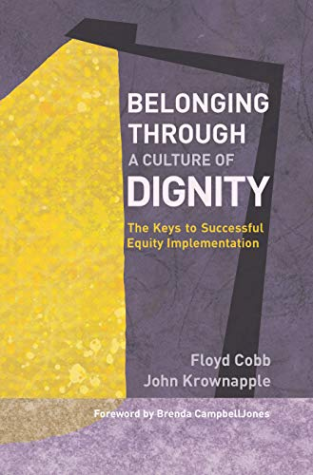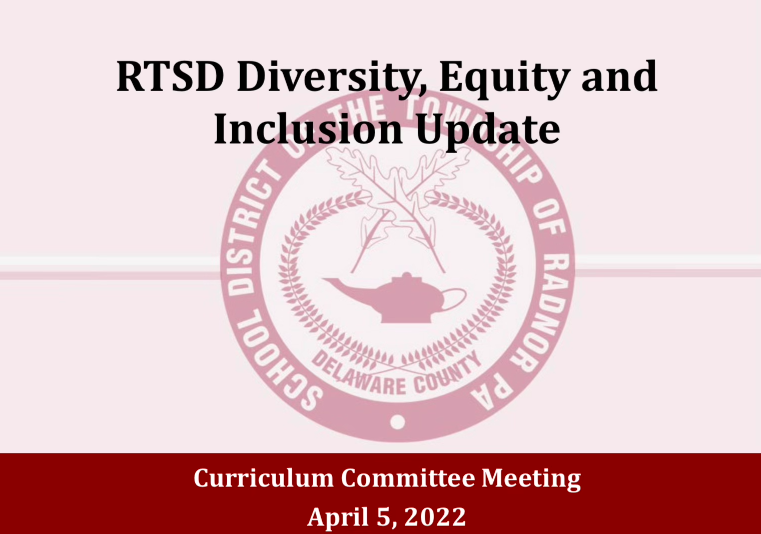The History and Future of Diversity, Equity, and Inclusion at Radnor
April 19, 2023
One prevailing concern among students, parents, and faculty members in the district is the lack of support and awareness in regard to Radnor’s DEI (Diversity, Equity and Inclusion) program. These policies have long remained at the top of Radnor’s priorities, known as district initiatives, but community members are routinely disappointed with the existing measures. In both classroom discussions and extracurricular events like Speak Up, students have shared feelings of isolation and alienation within school environments. Others have reported the lack of accommodations and understanding from teachers. These student accounts go against the very essence of the DEI program.
A reaction to the emerging opinions and legislation of the 1960s Civil Rights Movements, DEI initiatives were first designed to reduce discrimination within Corporate America. Today, these policies have expanded into other spaces, including education, and areas of diversity, such as gender, religion, and sexual orientation.
Released on April 7th of 2022, the latest update on Radnor’s initiatives with DEI reviewed the previous Curriculum Committee meeting, in which the district administration presented the year’s achievements and prospective steps. The presentation began with a summary on the history of the program at Radnor. Although formalized as a district initiative in June of 2020, efforts to pursue DEI began during the 2015-2016 school year. Initial progress took place in specific buildings, or “silos” as they were referred to in the meeting. RHS administration, for example, met with Dr. Anthony Stevenson and Dr. Courtney Portlock to begin integrating the objectives of the program into Radnor’s curricula and mentoring systems. The team also utilized data from College Board’s AP Potential platform to inform equitable decisions on student placement.
Between 2016 and 2017, the district coordinated with RHS alum Mubarak Lawrence to devise student support services intended to target issues of belonging and race relations. The Black Student Union (BSU) was also created, along with expansions of RHS’s classroom celebrations of Black History Month. Elani Dwyer, former president of the BSU and former member of the Curriculum Committee, mentioned that “representation within classrooms is extremely important.” This representation, among other goals, lies at the heart of the BSU’s mission. The following academic year, the Building and Central Office administration took an active role in monthly discussions on aiding minority and disadvantaged students. Select teachers also participated in workshops with the Delaware Valley Consortium of Excellence and Equity (DVCEE). These sessions aimed to equip teachers with the skills necessary to make learning environments safe and inclusive; to that end, the meetings included information on differentiated instruction, in which a students’ education is tailored to their unique learning strengths and needs.
An Equity Team of teachers, administrators, and staff members was developed between 2018 and 2019 to incorporate more voices into the DEI efforts. This team collaborated with Dr. Caprice Hollins, the co-founder of Cultures Connecting, an organization designed around the themes of equity and justice. ELP, or the Extended Learning Program, was also introduced to prioritize individualized learning for all students. Other advancements during this time include the creation of the Girl’s Empowerment Group at RHS, the voluntary DEI faculty book club, and the continued cooperation with RHS alum Reverend Bumper Howard of the Dream Leadership Academy to encourage the participation of African American Youth in school.
At the end of the 2020 academic year, active members of Radnor’s DEI efforts presented their work to the school board. Shortly after, the board approved DEI as an ongoing district initiative. This decision formalized the goals of the program, including the implementation of student advisory groups and the use of data to improve student experiences, similar to how the AP Potential platform was employed.
After exploring the progress of the DEI team, the presentation transitioned into the program’s current actions and goals. Projected before every person in the room were the following words: Every family, student, and staff member feels welcomed and safe at our schools. Diversity is celebrated, all are included, and decisions are made using an equity lens.
To transform these ideals into applicable steps, the team outlined four pillars of action, each with their own set of items and objectives.
Pillar I seeks to “increase student engagement and learning opportunities… in all curricular and extracurricular activities, create a District level DEI leadership team to make recommendations,” and “institute building and department level DEI teams.” The presenters noted that this pillar will receive the most priority, given that it will be achieved through not only an academic lens, but a social lens as well. Included in these specific goals were several action items, namely the implementation of a Multi-Tiered System of Support (MTSS), which aims to provide both “preventive and responsive” aid for students through the use of evidence-based practices to support students’ behavioral, social-emotional, and academic needs.

Another element of the Pillar I presentation was the consolidation of academic levels to promote smaller, more intimate class sizes and flexibility. The presenters explained that multiple course levels, such College Prep, Advanced, Honors, and AP/Integrated in the High School, introduce challenges to equitable placement. 2022 marked the first year in a five-year plan designed for this purpose. This academic year, 2022-2023, administration has and will continue to work toward consolidating the levels for the Math and Science classes for 9th grade. For more information on the consolidation of academic levels and the elimination of College Prep, view the January 2021 Curriculum Committee Presentation.
Pillar II, which focuses on the staff level, prioritizes the development of cultural awareness among teachers, and the expansion of staff opportunities. Through its partnership with SAGE Wellness, a training resource, the district hopes to continue district-wide workshops and implement building-level teams of volunteers. The presenters mentioned that one area of identified need from the previous year is incorporating nonprofessional staff, such as library aids, clerical staff, and custodians, into DEI initiatives – all staff members must be well versed in the language and objectives of the program. Elani stressed the need for “in-person and consistent” training sessions. “Transparency and accountability within workshops are valuable,” she noted. There also must be set measures of success to indicate the progress of training.
Pillar III expands upon the goals of staff engagement and seeks to embrace the voices of the community. As such, advisory groups have and will continue to be formed throughout the district. “It is important for students to have a voice, and feel heard and seen,” mentioned Elani. Student advisory committees not only foster leadership among minority students, but encourage “accountability of teachers and administration.” As she explained, “change starts with the students.”
The final, fourth pillar intends to broaden the initiative even further by recruiting, hiring, and retaining staff of all backgrounds. Representation within classrooms is profoundly important, and the district has registered with NEMNET Diversity Recruitment to actualize this goal. In our interview, Elani applauded the district’s measures to recruit and hire minority staff members, but highlighted the need for “even more representation, especially with substitute teachers.”
 Over the summer of 2022, all district staff members were provided with the book “Belonging Through a Culture of Dignity: The Keys to Successful Equity Implementation” to stimulate conversation and awareness on the topics of diversity, equity, and inclusion. Written by John Krownapple and Floyd Cobb, the novel outlines a comprehensive approach for educators to form lasting and valuable relationships with their students. Krownapple and Cobb indicate that safe and comforting environments are key to positive student behavior and performance. The district also organized a community discussion of the novel led by Krownapple on October 18, 2022. This conversation was part of a larger implementation of the book’s study, including training sessions and staff surveys. The study of the book continues as a multi-year initiative.
Over the summer of 2022, all district staff members were provided with the book “Belonging Through a Culture of Dignity: The Keys to Successful Equity Implementation” to stimulate conversation and awareness on the topics of diversity, equity, and inclusion. Written by John Krownapple and Floyd Cobb, the novel outlines a comprehensive approach for educators to form lasting and valuable relationships with their students. Krownapple and Cobb indicate that safe and comforting environments are key to positive student behavior and performance. The district also organized a community discussion of the novel led by Krownapple on October 18, 2022. This conversation was part of a larger implementation of the book’s study, including training sessions and staff surveys. The study of the book continues as a multi-year initiative.
2022 also saw the continuation of Radnor’s Early Learning Academy. Beginning in September of 2021, the program aids families in delivering pre-school education. The academy covers a variety of subjects and is located at Radnor Elementary School.
The framework of the DEI initiatives are not merely promising, but proven to have effective outcomes. Radnor is remarkably privileged given all that is at our disposal: the support from local and national organizations, the funding and infrastructure to implement these changes, and the overwhelming enthusiasm from the community. Somewhere along the line, however, we have allowed for a disconnect between the potential of these initiatives and their execution. The available information on the RTSD website, for instance, is hidden within the “District Initiatives” section. According to this website, further, the meetings of the Parent/PTO and Student Advisory Committees continue only through 2021. The website gives no indication as to any updates with these groups.
The words I saw projected on the wall of that April 7th meeting room have been spoken and written, in some form, since 2015. Now, eight years later, it is time we raise our voices and deepen the ink of our pens. We must ensure these words are not spoken in vain. We must prioritize the visibility and relevancy of these words. We must transform these words into action, celebrations, and truths.







